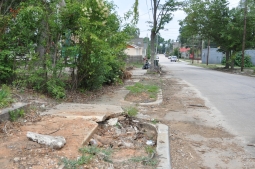Raleigh’s 1,190 miles of sidewalks aren’t enough.
Although the city-ranking website Walk Score ranks Raleigh as the country’s 36th most walkable city, some streets don’t have the sidewalks they need, and many streets are dangerous to cross. The group Transportation for America ranked Raleigh-Cary as the 13th most dangerous metro area for pedestrians in a 2011 study.
Related:
Transportation for America Study
Raleigh’s Walk Score Ranking
“I would say there are pockets that are very walkable,” said Alan Wiggs, the chair of Raleigh’s Bicycle and Pedestrian Advisory Commission. “It all depends on where you are in Raleigh, which is kind of unfair—certain areas are walkable, other areas are not.”[media-credit name=”Image by City of Raleigh” align=”alignleft” width=”300″] [/media-credit]
[/media-credit]
Raleigh’s new Comprehensive Pedestrian Plan is intended to change that, setting new standards for deciding which sidewalks get built first and establishing guidelines and best practices for sidewalk and intersection construction. The plan is available online for public comment through Nov. 16.
Transportation Planner Fleming El-Amin said the Transportation for America ranking has been a major impetus for the city to improve its pedestrian policies and programs.
Under the current sidewalk-ranking system, El-Amin said, the city funds projects based partly on “whether or not it was along a major thoroughfare, if there were connections to schools and parks. Then we looked at cost. We did not look at need. We did not analyze if there were an issue of pedestrians struck by cars. We did not look at socio-economic data, how many people in the area are without cars, transit-dependent, had to walk and didn’t have a choice.”
[media-credit id=25 align=”alignright” width=”266″] [/media-credit]
[/media-credit]
Money for Sidewalks
In 2011, voters approved $40 million in transportation bonds, including $10 million for pedestrian projects. With that money available, the Comprehensive Pedestrian Plan drops finance as a factor and focuses on two standards: demand and need.
The bond money includes $4.75 million for new sidewalks, $4 million for repairs and $3 million for sidewalks requested through the public petition process. Property owners no longer have to pay an assessment to help cover the cost of sidewalks built when neighbors petition to have them installed.
What’s In the Plan
The plan identifies four overall guidelines for city pedestrian policy, based on pedestrian surveys: Install needed sidewalks, maintain existing sidewalks, make it easier to cross the street and change motorists’ behavior toward pedestrians.
The plan also recommends best practices such as buffer zones between pedestrians and traffic, keeping sidewalks free of obstructions and minimizing the number of access points into and out of roadside properties.
The best practices for street crossings include crossing islands mid-street, highly visible crosswalks and, in some locations, “high intensity activated crosswalks” that stop traffic for pedestrians.
•The highest pedestrian crash rates per mile are on Tarboro Road, Salisbury Street, Hillsborough Street and Blount Street.
•Pedestrian crashes tend to cluster around transit stops.
•Motorists often fail to yield to pedestrians when turning in and out at driveways.
•Pedestrians often fail to yield or to choose a safe gap when crossing at mid-block locations. Forty-seven percent of collisions occurred at non-intersections, but they account for 75 percent of deaths.
•A majority of fatalities occur in collisions where the pedestrian was struck by a through vehicle while crossing the street, or the pedestrian dashed into the road.
•People of black/African American heritage account for 46 percent of Raleigh pedestrian collisions, though they only make up 29 percent of the population. Hispanics account for 11 percent, whites 39 percent and Asians and other groups 2 percent.
Source: Comprehensive Pedestrian Plan
Ideas for improving drivers’ behavior ranges from the physical—intersection design and signal improvements—to driver education and enforcing moving and parking violations at crosswalks.
El-Amin said in some busy areas of Raleigh, “there are more pedestrians on the streets than cars.”
Pedestrian counts in much of downtown Raleigh have recorded 10,000 street crossings a day because of colleges and hospitals drawing foot traffic.
What’s Next
After the Raleigh Office of Transportation Planning reviews the public comments and decides whether any revisions are needed, it will take the plan to City Council for approval at the Dec. 4 meeting. If the plan isn’t adopted immediately, El-Amin said, the department hopes to see it approved in January.
Come next summer, he said, the city should be holding design hearings for the initial sidewalk projects. Construction should be begin by the fall of 2013.
The plan identifies the priorities and pedestrian programs Raleigh will roll out over the next decade. Beyond 10 years, it recommends the city look at “big idea” pedestrian projects: Pedestrian overpasses, traffic underpasses or taking two parallel streets and reserving one of them for pedestrians and bicycles.
According to the plan, to justify projects that ambitious, they would have to represent major links in the pedestrian network, with lots of political and community support.
The plan’s appendix lists the projects that will be budgeted for fiscal year 2013 if the council approves the plan.
The top five:
•Green Road from New Hope Church Road to Greenock Drive: 1,200 feet.
•New Home Church Road from Wake Forest Road to Brentwood Road: 4,500 feet.
•Capital Boulevard from 1-440 to Brentwood Road: 2,400 feet
•Clark Avenue from Woodburn Road to Bellwood Drive: 1,100 feet.
•Martin Luther King Boulevard from Peyton Street to Glenbrook Drive: 2,100 feet.
 [/media-credit]
[/media-credit]City of Raleigh
One of the maps in the Comprehensive Pedestrian Plan show new sidewalks needed..
